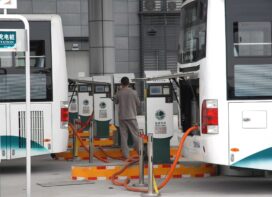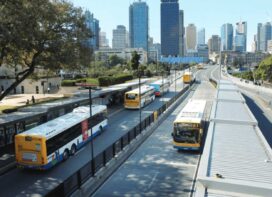
While public transport buses have long been part of India’s landscape as an inexpensive and inclusive mode of travel, it is now gathering momentum as a sustainable, eco-friendly and technology driven component of India’s urban and regional planning. The task of incorporating technology is not easy. The buses are new but mega cities house mega population and infrastructure is yet to catch up to take full advantage of advanced solutions to cover the distance and that last mile. The many stakeholders involved in the undertaking include the central and state governments, bus transport agencies, bus manufacturers, hardware and software technology developers and finally, the commuter. Trafficinfratech’s Rajashri Ramakrishnan spoke to Industry Experts and Government authorities who shared a wide range of views on bus transport solutions, challenges and innovations.
Bus operation is not a profitable business. It is basically a service to the nation, in my opinion. Currently, data related to commuter travel is confined to government databases. It must be shared and made open to third-party developers so they can create new applications.
– Atul Kumar
Bus operation is not just about ferrying passengers from point to point but also about being efficient, adhering to schedules, being predictable about the journey and giving comfort to commuters, according to Atul Kumar, General Manager – Delhi Integrated Multi-Modal Transit System Limited. This is not an easy task in major cities where the population is large, traffic heterogenous and the width of roads, inadequate.
From an operational perspective, schedule, speed, bunching and point-of-interest need to be considered, he said. The bus journey begins when it leaves the depot. Its location is tracked and there is supervision to ensure the bus is running on a designated route without getting diverted, is driven at a permissible speed and headway maintained between buses to ensure there is no bunching at the point-of-interest, also known as the bus-stop. Commuters can board and disembark from the bus only at the point-of-interest. The POIs are geo-fenced within a 15-30 metre radius where the bus slows down to a stop and then picks up speed to continue on its journey.
BMTC is making great efforts to implement the National Common Mobility Card (NCMC) project under financial assistance from MoRTH. However, the large population and unpredictable traffic in Bengaluru is compelling BMTC to explore the possibility of incorporating other advanced features in buses.
– R Ramachandran (IAS)
A key aspect of bus operations is ease of commute for passengers. The Bengaluru Metropolitan Transport Corporation (BMTC) buses operate tailor-made services to suit commuters including those from the IT community and the economically weaker sections. R Ramachandran (IAS), Managing Director – Bengaluru Metropolitan Transport Corporation, said, “Currently, BMTC is operating 5635 schedules, covering 11.49 lakh kms and servicing 40 lakh passengers daily. Fleet augmentation, affordable bus fares with simple ticket handling, 100% zero-emission vehicles, bus priority lanes across key corridors in the city, integrated public transport hubs for effective physical integration between urban and rural services, fare and information integration across public transport modes through hardware and software initiatives like smart cards, mobile apps, smart tickets and offline initiatives and integrating Intermediate Public Transport (IPT) through planning and infrastructure measures are required to make bus transport passenger-friendly.”
Globally, India is much ahead of other countries in implementing ITS in buses. We are behind the US in automated ticketing, but we shall get there too. We are getting into providing end-to-end solutions including signages for buses, depot management, planning and scheduling and inventory management. We have also started giving ETAs of buses at bus stops
– Vinay Jain
While DIMTS develops its own bus tracking systems, Masstrans, which started with LEDs in buses so commuters could read bus numbers and destinations from a distance of under 100mtrs, also incorporated voice announcement systems, surveillance cameras, GPS for tracking and panic buttons in buses. “CAN or Controller Area Network interface is a vehicle bus standard designed to allow microcontrollers and devices to communicate with each other and Masstrans is able to provide vehicle health parameters to bus manufacturers using this interface”, said Vinay Jain, Managing Director – MassTrans Technologiis Pvt. Ltd. For intercity buses, Masstrans has introduced ADAS and VSL cameras that raise alerts to the backend if the driver is not concentrating on the road or is distracted. People counters for all EV intra-city buses have been made mandatory by the government and Jain explained that the moment bus doors open, cameras start counting the number of people exiting and entering the bus. This helps the revenue department know how many tickets have been sold. Intercity buses have an alcohol-detection system into which the driver blows, and only if he is declared clean by the system will he be able to start the bus, he added.
In BMTC, 90% of the buses have vehicle tracking units, panic button, bus surveillance system and ETMs, added Ramachandran. However, all the electric buses have the ITS components. Automatic Passenger counters and Automatic Fare Collections Systems (AFCS) though, are yet to be implemented. BMTC also has a mobile app with women-safety features. An SOS option helps commuters send an alert to the Sarathi patrol as well as family members during distress or an emergency.
Given the high penetration of mobile phones today, we can use that as a platform to make live tracking and ticketing available to everyone. Mobile phones help solve for quick distribution compared to cards and hence could prove very powerful. Ticketing systems using cards and mobile both could help us move to a completely cashless experience.
– Vinayak Bhavnani
Vinayak Bhavnani, Co-Founder and CTO – Chalo Mobility however felt technology penetration currently has been very low in public transport buses. Though the intercity bus segment fares better in terms of technology adoption, and as a result, offers better experience, both the segments still have a huge opportunity to make services passenger-friendly and run buses effectively. To make them reliable, bus availability information needs to be more accessible. Live tracking systems compensate for missing visibility and this empowers commuters to use buses more efficiently, he said. Another source of inconvenience is payments for bus tickets in cash when people are switching to digital methods. Systems that have enabled digital payment growth in other segments are falling short of delivering the same outcomes for buses. AFCS and an Electronic Ticket Issuing Machine (ETIM) are being adopted as the first step towards digitisation.
Government policies can help push technology adoption in buses. The AIS-140 mandates that all public transport vehicles be equipped with a GPS tracking device. This makes the whole fleet trackable and improves safety, said Bhavnani. Policies that push EV adoption will help reduce operational costs, offer better bus quality, and accrue major environmental benefits. Without a government mandate, digital payments will not be adopted for bus ticketing even though it will help identify ridership behaviour. The data would help make bus operators bankable and eligible for loans, said Bhavnani. Ramachandran added that BMTC would require the government to provide consistent viability gap funding to operate the on-demand services which were running under a loss. Approval to increase bus fares to compensate the additional financial burden and financial assistance to increase the fleet were other expectations from the state government, he said.
“While there is a policy in place for new EV buses, the older ones on the road continue to be bereft of automated systems as it is difficult to retrofit running buses with wiring,” added Vinay Jain. “ITS is provided only to the OE as wiring is done at the manufacturing stage. Wireless technology could be an option but this again would need a mandate from the government.” Bhavnani however stated that since many technology solutions are brand-agnostic, retrofitting older buses with tap-in tap-out validators on bus doors and fitting consoles to assist the driver in running the bus independently without the presence of conductors could be viable solutions.
Bus stops are also seeing automation with Passenger Information System (PIS) display boards being installed in major bus stations providing ETA and ETD of buses based on live tracking. This reduces waiting time and helps commuters with their journey, said Ramachandran. According to Bhavnani, while these provide more accurate information compared to timetables, this information is often available at bus stops after the passenger has arrived there. Ideally, passengers should be equipped with the information even before they come to the bus stop.
“To enable passenger feedback, a robust complaints redressal system has been established along with a set of SOPs to address commuter concerns and suggestions on improving services by BMTC through easily accessible channels”, explained Ramachandran. Bhavnani said passengers could share their feedback via apps made available by the service provider, surveys, on-ground collection and social media platforms.
Moving forward, innovations in the offing include developing blind spot detection cameras required when large buses have to make a turn on city roads and 360-degree cameras used during reversing vehicles. There is also a plan to introduce pay collection in some city buses where people can pay in any mode including QR code and RFID for their tickets, said Jain.
Providing bus service to unplanned city development can be challenging as 100% route coverage is not possible. Multimodal transport is important for end-to-end travel and all sectors, including the organised (metros), partially organised (buses) and unorganised (autorickshaws) need to be brought under the purview of synchronised planning. Currently they are all working in silos. There is a need for a transport stack that captures the complete journey to aid commuters and city planners, Kumar said. The battery in EV buses has finite power and one cannot accurately predict charge vs distance travelled. Existing systems need to be polished with AI algorithms and machine learning layers, he concluded.
 TrafficInfraTech Magazine Linking People Places & Progress
TrafficInfraTech Magazine Linking People Places & Progress









